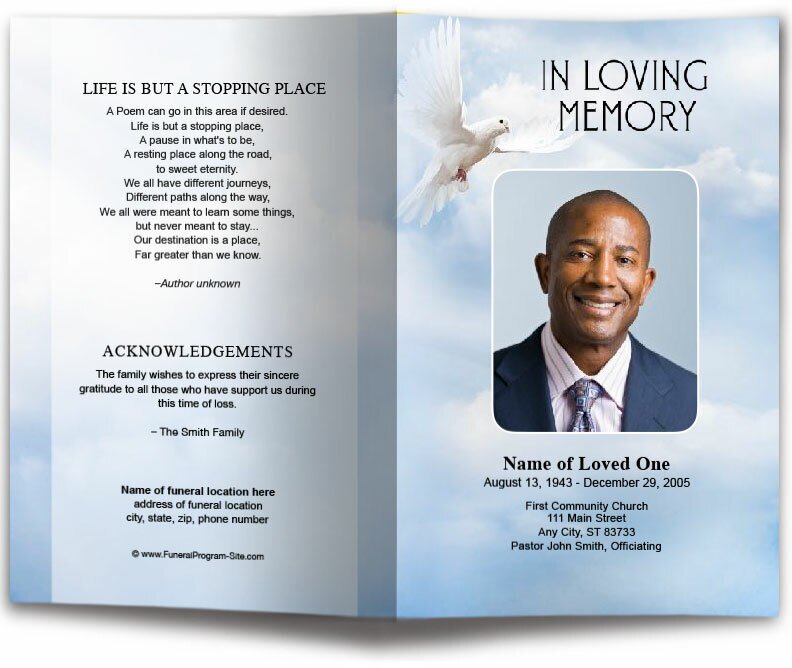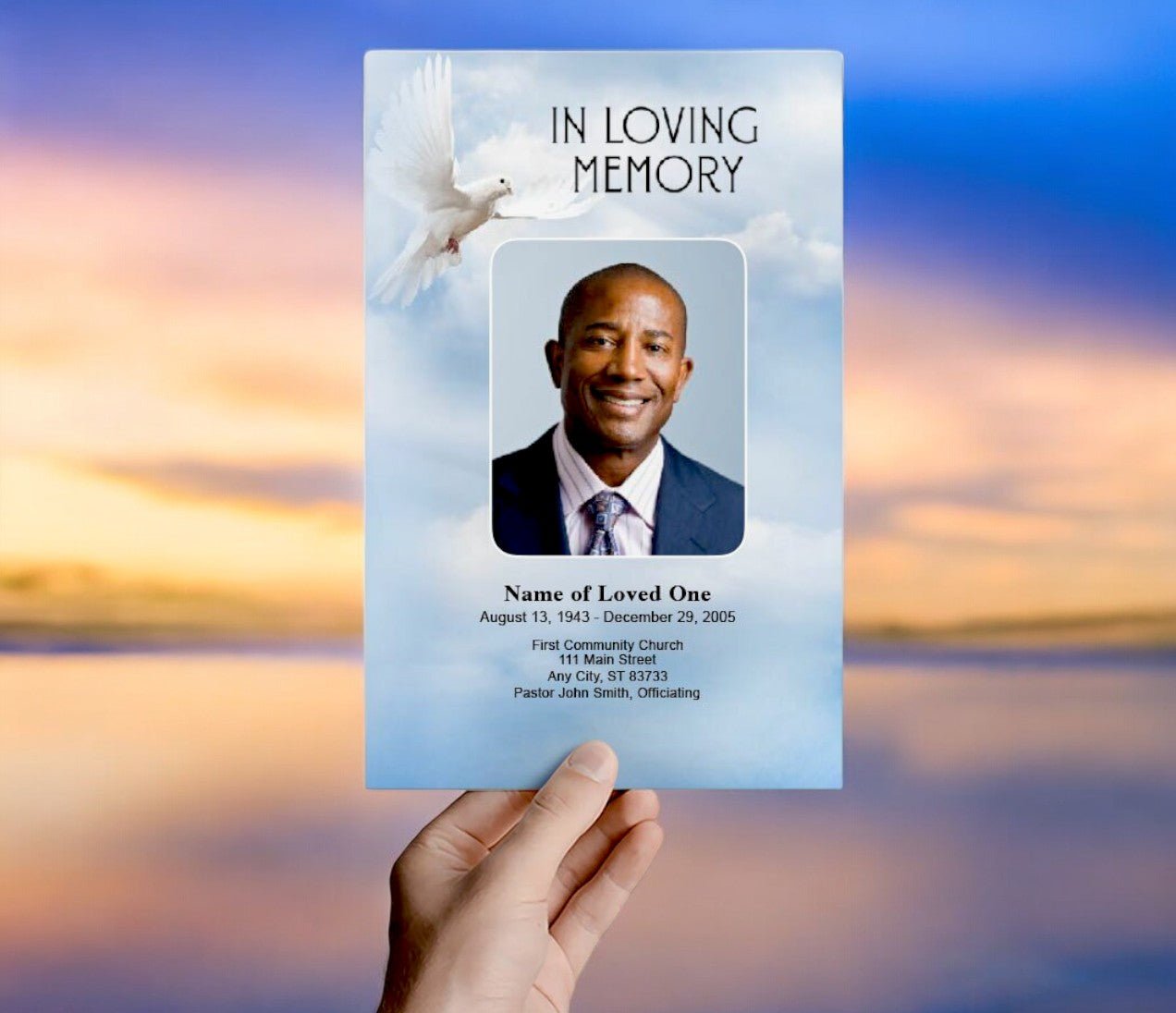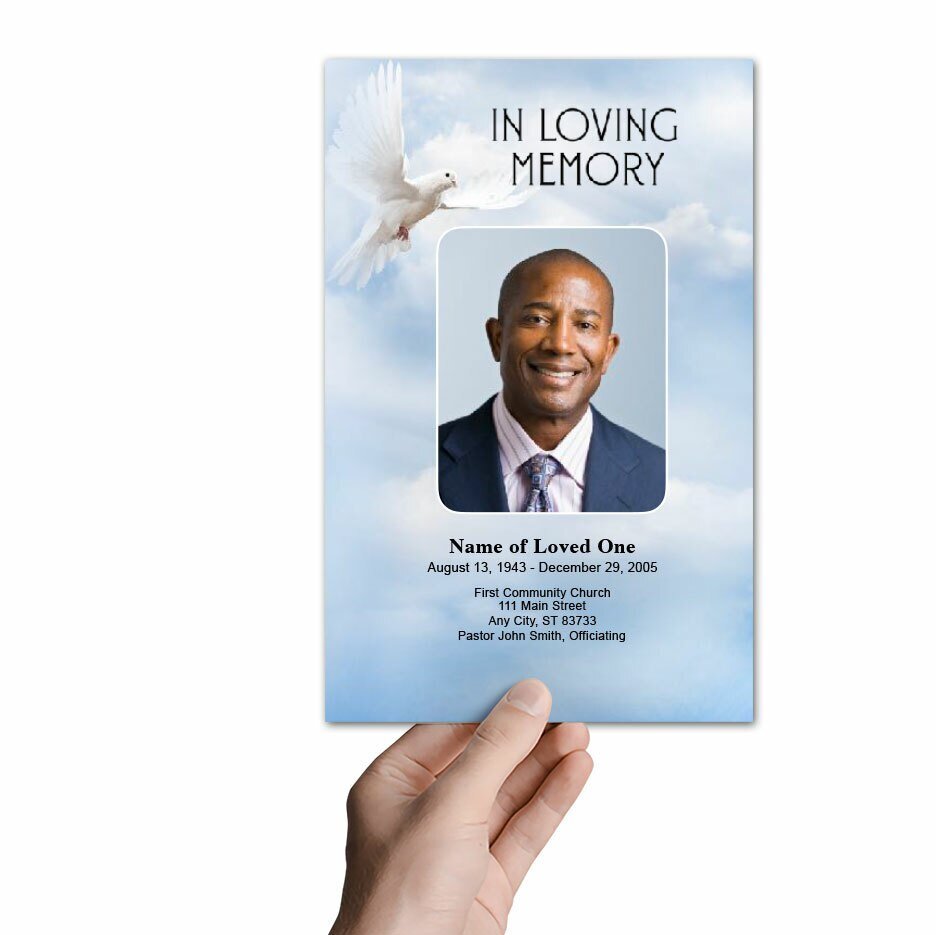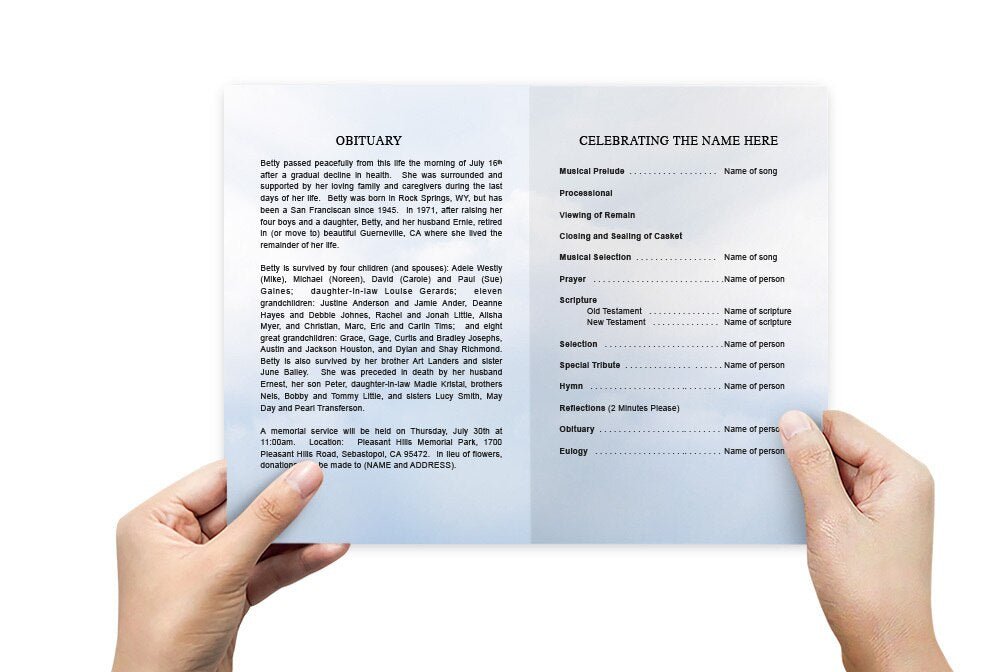Funeral Mass Program Template: A Guide to Creating a Meaningful Tribute

A funeral mass program is a printed booklet that provides the order of service for a Catholic funeral mass, guiding attendees through the religious rites, prayers, hymns, and readings. It serves as both a keepsake for mourners and a helpful guide during the service. Creating a funeral mass program requires attention to detail and sensitivity, ensuring it reflects the deceased's faith and the solemnity of the occasion. This article will guide you through the essential elements of a funeral mass program template, its importance, and tips for designing a meaningful and respectful tribute.
Importance of a Funeral Mass Program
A funeral mass program serves several purposes:
-
Guides Attendees Through the Service: The Catholic funeral mass is a structured and deeply symbolic service with specific prayers, hymns, and readings. A program helps attendees follow along and participate, especially for those unfamiliar with the liturgy.
-
Provides a Keepsake: The program acts as a lasting memento for attendees, helping them remember the deceased and the special moments shared during the service.
-
Reflects the Deceased’s Faith and Life: A well-designed program can include personalized elements such as favorite scriptures, hymns, and photographs, making it a fitting tribute that honors the deceased's spiritual journey and life.
-
Helps Alleviate Stress for the Family: Having a structured program ensures that the service flows smoothly, reducing the stress of managing the order of events during an emotionally challenging time.
Essential Elements of a Funeral Mass Program Template
When creating a funeral mass program, it’s important to include all the elements that will guide attendees through the service while also allowing for personalization. Here’s a breakdown of the key components that are typically included in a funeral mass program:
1. Cover Page
The cover page is the first thing attendees will see, so it should be thoughtfully designed to set the tone for the service. Key elements to include on the cover page are:
- Title: A simple title such as "In Loving Memory," "Celebration of Life," or "A Funeral Mass for [Name]."
- Full Name of the Deceased: Include the full name of the deceased, including any titles or nicknames they were known by.
- Dates: The date of birth and date of passing of the deceased.
- Photo: A meaningful photo of the deceased that reflects their personality and spirit.
- Date and Location of the Service: The date of the funeral mass and the name of the church or location where it is being held.
- Religious Symbols: A cross or other religious symbol can be included to emphasize the Catholic nature of the service.
2. Order of Service
The order of service section outlines the flow of the funeral mass, helping attendees understand the sequence of events and when to participate. This section generally includes:
- Entrance Procession: Details of the entrance hymn and procession, including the name of the hymn and any special participants (such as pallbearers or family members).
- Introductory Rites: Prayers and blessings that open the service, usually led by the priest.
- Liturgy of the Word: The readings from the Old Testament, Psalms, New Testament, and the Gospel. Include the names of the readers and the specific scripture passages chosen.
- Homily: A short sermon or reflection given by the priest or celebrant, providing spiritual comfort and reflections on the deceased’s life.
- Prayers of the Faithful: Intercessory prayers that may be read by family members or friends. Include a list of the intentions that will be prayed for.
- Liturgy of the Eucharist: The presentation of the gifts, Eucharistic Prayer, and Communion. Include any details on the hymns or music that will be played during this part.
- Final Commendation and Farewell: The concluding prayers and commendation of the deceased’s soul to God. Include details of the recessional hymn and the departure from the church.
3. Music and Hymns
Music plays an essential role in the Catholic funeral mass, adding to the solemnity and sacredness of the service. A dedicated section for music and hymns in the program helps attendees follow along and participate. Include:
- List of Hymns: A list of the hymns to be sung during the service, along with the lyrics or references to hymn numbers if using a hymnal.
- Musicians and Singers: Acknowledgement of any musicians or choir members performing during the service.
4. Readings and Reflections
Include a section for the chosen scripture readings, reflections, or poems. This section should detail:
- Scripture Readings: The specific Bible passages chosen for the service, such as from the Old Testament, Psalms, New Testament, and Gospel.
- Reflection or Eulogy: If a family member or friend is giving a eulogy or personal reflection, provide their name and a brief introduction.
5. About the Deceased
A brief section providing an overview of the deceased’s life, accomplishments, family, and character can personalize the program. This may include:
- Obituary or Biography: A short obituary or biography that highlights key moments in the deceased’s life.
- Family Members: A list of surviving family members, such as spouses, children, grandchildren, and siblings.
6. Acknowledgments and Thank You Notes
The family may wish to express their gratitude to those who have supported them during their time of loss. This section can include:
- Acknowledgments: A note of thanks to everyone who attended the service, as well as to those who provided support, flowers, donations, or other acts of kindness.
- Special Mentions: Recognition of those who participated in the service, including pallbearers, clergy, and musicians.
7. Final Prayer or Blessing
Conclude the program with a final prayer or blessing. This could be a traditional Catholic prayer or a personalized message that provides comfort and hope.
8. Back Cover
The back cover of the program can include:
- Final Scripture or Quote: A meaningful scripture verse, poem, or quote that reflects the faith and character of the deceased.
- Contact Information: Contact information for the funeral home or family for those who may wish to send condolences or make memorial donations.
Tips for Creating a Funeral Mass Program Template
Here are some tips for creating a well-organized and meaningful funeral mass program:
- Choose a Simple, Elegant Design: The design of the program should be respectful and understated. Use soft colors, religious imagery, and easy-to-read fonts.
- Use High-Quality Photos: Choose a clear and high-quality photo of the deceased for the cover. Make sure the image is well-cropped and appropriate for a memorial service.
- Proofread Carefully: Ensure that all names, dates, and scripture references are accurate. A typo or error can be distracting and may affect the program’s quality.
- Personalize Where Possible: While the structure of a Catholic funeral mass is relatively fixed, there is room for personalization. Include favorite hymns, readings, or quotes that reflect the deceased’s personality and faith.
- Consider the Size and Layout: Most funeral programs are printed in a bifold (single sheet folded in half) or trifold (two folds creating three panels) format. Choose a size that allows for all necessary information while remaining easy to handle.
- Print on Quality Paper: Choose quality cardstock or paper for printing to give the program a polished and professional appearance. This makes the program more durable as a keepsake.
A funeral mass program is a printed booklet that provides the order of service for a Catholic funeral mass, guiding attendees through the religious rites, prayers, hymns, and readings. It serves as both a keepsake for mourners and a helpful guide during the service. Creating a funeral mass program requires attention to detail and sensitivity, ensuring it reflects the deceased's faith and the solemnity of the occasion. This article will guide you through the essential elements of a funeral mass program template, its importance, and tips for designing a meaningful and respectful tribute.
Importance of a Funeral Mass Program
A funeral mass program serves several purposes:
-
Guides Attendees Through the Service: The Catholic funeral mass is a structured and deeply symbolic service with specific prayers, hymns, and readings. A program helps attendees follow along and participate, especially for those unfamiliar with the liturgy.
-
Provides a Keepsake: The program acts as a lasting memento for attendees, helping them remember the deceased and the special moments shared during the service.
-
Reflects the Deceased’s Faith and Life: A well-designed program can include personalized elements such as favorite scriptures, hymns, and photographs, making it a fitting tribute that honors the deceased's spiritual journey and life.
-
Helps Alleviate Stress for the Family: Having a structured program ensures that the service flows smoothly, reducing the stress of managing the order of events during an emotionally challenging time.
Essential Elements of a Funeral Mass Program Template
When creating a funeral mass program, it’s important to include all the elements that will guide attendees through the service while also allowing for personalization. Here’s a breakdown of the key components that are typically included in a funeral mass program:
1. Cover Page
The cover page is the first thing attendees will see, so it should be thoughtfully designed to set the tone for the service. Key elements to include on the cover page are:
- Title: A simple title such as "In Loving Memory," "Celebration of Life," or "A Funeral Mass for [Name]."
- Full Name of the Deceased: Include the full name of the deceased, including any titles or nicknames they were known by.
- Dates: The date of birth and date of passing of the deceased.
- Photo: A meaningful photo of the deceased that reflects their personality and spirit.
- Date and Location of the Service: The date of the funeral mass and the name of the church or location where it is being held.
- Religious Symbols: A cross or other religious symbol can be included to emphasize the Catholic nature of the service.
2. Order of Service
The order of service section outlines the flow of the funeral mass, helping attendees understand the sequence of events and when to participate. This section generally includes:
- Entrance Procession: Details of the entrance hymn and procession, including the name of the hymn and any special participants (such as pallbearers or family members).
- Introductory Rites: Prayers and blessings that open the service, usually led by the priest.
- Liturgy of the Word: The readings from the Old Testament, Psalms, New Testament, and the Gospel. Include the names of the readers and the specific scripture passages chosen.
- Homily: A short sermon or reflection given by the priest or celebrant, providing spiritual comfort and reflections on the deceased’s life.
- Prayers of the Faithful: Intercessory prayers that may be read by family members or friends. Include a list of the intentions that will be prayed for.
- Liturgy of the Eucharist: The presentation of the gifts, Eucharistic Prayer, and Communion. Include any details on the hymns or music that will be played during this part.
- Final Commendation and Farewell: The concluding prayers and commendation of the deceased’s soul to God. Include details of the recessional hymn and the departure from the church.
3. Music and Hymns
Music plays an essential role in the Catholic funeral mass, adding to the solemnity and sacredness of the service. A dedicated section for music and hymns in the program helps attendees follow along and participate. Include:
- List of Hymns: A list of the hymns to be sung during the service, along with the lyrics or references to hymn numbers if using a hymnal.
- Musicians and Singers: Acknowledgement of any musicians or choir members performing during the service.
4. Readings and Reflections
Include a section for the chosen scripture readings, reflections, or poems. This section should detail:
- Scripture Readings: The specific Bible passages chosen for the service, such as from the Old Testament, Psalms, New Testament, and Gospel.
- Reflection or Eulogy: If a family member or friend is giving a eulogy or personal reflection, provide their name and a brief introduction.
5. About the Deceased
A brief section providing an overview of the deceased’s life, accomplishments, family, and character can personalize the program. This may include:
- Obituary or Biography: A short obituary or biography that highlights key moments in the deceased’s life.
- Family Members: A list of surviving family members, such as spouses, children, grandchildren, and siblings.
6. Acknowledgments and Thank You Notes
The family may wish to express their gratitude to those who have supported them during their time of loss. This section can include:
- Acknowledgments: A note of thanks to everyone who attended the service, as well as to those who provided support, flowers, donations, or other acts of kindness.
- Special Mentions: Recognition of those who participated in the service, including pallbearers, clergy, and musicians.
7. Final Prayer or Blessing
Conclude the program with a final prayer or blessing. This could be a traditional Catholic prayer or a personalized message that provides comfort and hope.
8. Back Cover
The back cover of the program can include:
- Final Scripture or Quote: A meaningful scripture verse, poem, or quote that reflects the faith and character of the deceased.
- Contact Information: Contact information for the funeral home or family for those who may wish to send condolences or make memorial donations.
Tips for Creating a Funeral Mass Program Template
Here are some tips for creating a well-organized and meaningful funeral mass program:
- Choose a Simple, Elegant Design: The design of the program should be respectful and understated. Use soft colors, religious imagery, and easy-to-read fonts.
- Use High-Quality Photos: Choose a clear and high-quality photo of the deceased for the cover. Make sure the image is well-cropped and appropriate for a memorial service.
- Proofread Carefully: Ensure that all names, dates, and scripture references are accurate. A typo or error can be distracting and may affect the program’s quality.
- Personalize Where Possible: While the structure of a Catholic funeral mass is relatively fixed, there is room for personalization. Include favorite hymns, readings, or quotes that reflect the deceased’s personality and faith.
- Consider the Size and Layout: Most funeral programs are printed in a bifold (single sheet folded in half) or trifold (two folds creating three panels) format. Choose a size that allows for all necessary information while remaining easy to handle.
- Print on Quality Paper: Choose quality cardstock or paper for printing to give the program a polished and professional appearance. This makes the program more durable as a keepsake.
Funeral Mass Program Template Conclusion
A funeral mass program is an essential part of a Catholic funeral service, providing both guidance and comfort to attendees. By thoughtfully designing a program that includes all the key elements—such as the order of service, readings, hymns, and personal reflections—you can create a meaningful tribute that honors the faith and memory of the deceased. A well-crafted program not only enhances the service itself but also serves as a cherished keepsake for family and friends, helping them remember and celebrate the life of their loved one.
Conclusion
A funeral mass program is an essential part of a Catholic funeral service, providing both guidance and comfort to attendees. By thoughtfully designing a program that includes all the key elements—such as the order of service, readings, hymns, and personal reflections—you can create a meaningful tribute that honors the faith and memory of the deceased. A well-crafted program not only enhances the service itself but also serves as a cherished keepsake for family and friends, helping them remember and celebrate the life of their loved one.





























